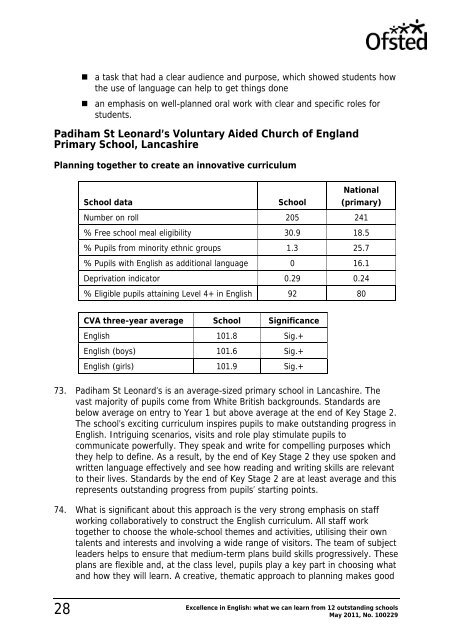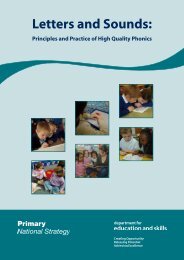Free download of:Excellence in English - Department for Education
Free download of:Excellence in English - Department for Education
Free download of:Excellence in English - Department for Education
Create successful ePaper yourself
Turn your PDF publications into a flip-book with our unique Google optimized e-Paper software.
28<br />
a task that had a clear audience and purpose, which showed students how<br />
the use <strong>of</strong> language can help to get th<strong>in</strong>gs done<br />
an emphasis on well-planned oral work with clear and specific roles <strong>for</strong><br />
students.<br />
Padiham St Leonard’s Voluntary Aided Church <strong>of</strong> England<br />
Primary School, Lancashire<br />
Plann<strong>in</strong>g together to create an <strong>in</strong>novative curriculum<br />
School data School<br />
National<br />
(primary)<br />
Number on roll 205 241<br />
% <strong>Free</strong> school meal eligibility 30.9 18.5<br />
% Pupils from m<strong>in</strong>ority ethnic groups 1.3 25.7<br />
% Pupils with <strong>English</strong> as additional language 0 16.1<br />
Deprivation <strong>in</strong>dicator 0.29 0.24<br />
% Eligible pupils atta<strong>in</strong><strong>in</strong>g Level 4+ <strong>in</strong> <strong>English</strong> 92 80<br />
CVA three-year average School Significance<br />
<strong>English</strong> 101.8 Sig.+<br />
<strong>English</strong> (boys) 101.6 Sig.+<br />
<strong>English</strong> (girls) 101.9 Sig.+<br />
73. Padiham St Leonard’s is an average-sized primary school <strong>in</strong> Lancashire. The<br />
vast majority <strong>of</strong> pupils come from White British backgrounds. Standards are<br />
below average on entry to Year 1 but above average at the end <strong>of</strong> Key Stage 2.<br />
The school’s excit<strong>in</strong>g curriculum <strong>in</strong>spires pupils to make outstand<strong>in</strong>g progress <strong>in</strong><br />
<strong>English</strong>. Intrigu<strong>in</strong>g scenarios, visits and role play stimulate pupils to<br />
communicate powerfully. They speak and write <strong>for</strong> compell<strong>in</strong>g purposes which<br />
they help to def<strong>in</strong>e. As a result, by the end <strong>of</strong> Key Stage 2 they use spoken and<br />
written language effectively and see how read<strong>in</strong>g and writ<strong>in</strong>g skills are relevant<br />
to their lives. Standards by the end <strong>of</strong> Key Stage 2 are at least average and this<br />
represents outstand<strong>in</strong>g progress from pupils’ start<strong>in</strong>g po<strong>in</strong>ts.<br />
74. What is significant about this approach is the very strong emphasis on staff<br />
work<strong>in</strong>g collaboratively to construct the <strong>English</strong> curriculum. All staff work<br />
together to choose the whole-school themes and activities, utilis<strong>in</strong>g their own<br />
talents and <strong>in</strong>terests and <strong>in</strong>volv<strong>in</strong>g a wide range <strong>of</strong> visitors. The team <strong>of</strong> subject<br />
leaders helps to ensure that medium-term plans build skills progressively. These<br />
plans are flexible and, at the class level, pupils play a key part <strong>in</strong> choos<strong>in</strong>g what<br />
and how they will learn. A creative, thematic approach to plann<strong>in</strong>g makes good<br />
<strong>Excellence</strong> <strong>in</strong> <strong>English</strong>: what we can learn from 12 outstand<strong>in</strong>g schools<br />
May 2011, No. 100229
















